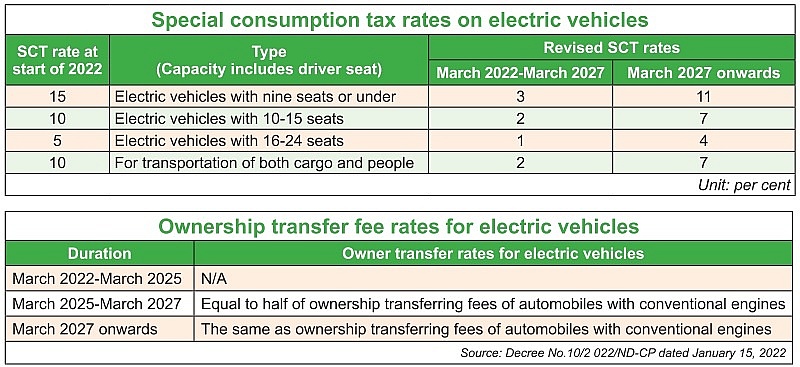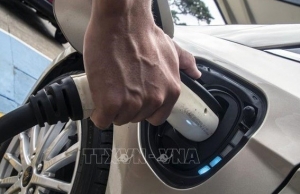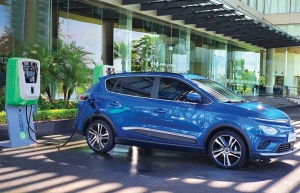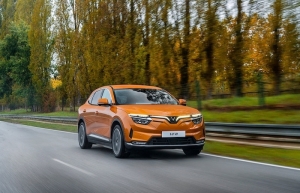How electric vehicles can shape the auto industry
 |
| Vu Tan Cong-Deputy director-general Vietnam Automobile Industry and Trading Business Consultants |
To help achieve such targets, in January the National Assembly passed a law to ensure special consumption tax (SCT) rates are greatly decreased to encourage people to use EVs (Table 1) for their means of transportation. At the same time, the ownership-transferring fee rates for such vehicles are noticeably decreased as well (Table 2).
In July, the prime minister promulgated Decision No.876/QD-TTg on approving the action program for transition to green energy and mitigation of carbon dioxide and methane emissions from transportation. For road transportation for the rest of this decade, the manufacturing, assembling, importing, and converting of conventional automobiles into EVs will be promoted; as well as developing a charging station network to meet the demands of individuals and businesses.
For road transportation after 2030, the manufacturing, assembling, and importing of automobiles powered by conventional engines will be, step by step, limited and stopped by 2040. By 2050, all automobiles to be manufactured, assembled, and imported must be EVs. By 2050, the charging station network development will be completed nationwide.
For urban traffic, by 2025 all newly purchased city buses must be electric. Proportions of public transportation by electric city buses by 2030 will be 45-50 per cent for Hanoi, 25 per cent for Ho Chi Minh City, 25-35 per cent for Danang, 20 per cent for Can Tho city, 10-15 per cent for Haiphong, and 5 per cent at least for 1st-grade urban areas.
Meanwhile, by 2030, the proportions of EVs will be 50 per cent at least, and 100 per cent of newly purchased taxis will be EVs. By 2050, all city buses and taxis must be electric. The proportion of such vehicles in public transportation are 40 per cent in special urban areas and 10 per cent in 1st-grade urban areas, at least.
 |
By 2030, with a forecasted population of about 105 million people and average yearly GDP growth rates of about 7 per cent, the Vietnam automobile market demand is projected at 1.8-2 million units.
Realising the business opportunities, many current automobile manufacturers have planned the manufacturing and distribution of EVs in Vietnam. VinFast stopped manufacturing passenger cars with traditional engines and started manufacturing them earlier this year for both domestic and export market demands. In addition, some other firms have also planned the manufacturing and distributing for both markets.
However, Vietnam’s EV manufacturing industry is facing many challenges. The country’s material production is now at a low level of development. Vietnam has no technologies for the manufacturing of key components like lithium batteries, electric motors, inverters, and other electronic components. Most of the tech to manufacture components is bought or transferred from foreign manufacturers.
In addition, EVs need a nationwide charging station network funded by manufacturers and other investors to become popular. At present, the network in Vietnam is still very limited, which makes potential customers hesitant to buy.
Investments in EV manufacturing are also enormous, ranging up to several billion US dollars. Not many investors have enough capital to invest in the manufacturing and distributing businesses.
Finally, tech regulations on safety and environmental protection for EVs and charging station networks are not available yet. It is advisable for the government to promulgate national technical regulations at the earliest time. In addition, the government must consider and promulgate some support and incentive policies for manufacturers and consumers.
 | Efforts needed to encourage travellers to use e-vehicles A legal framework, support policies and a concerted infrastructure system are needed to encourage people to switch to using electric vehicles, according to Director of VinFast’s charging station development centre Vu Thang. |
 | Infrastructure crucial for e-car future Green and cleaner transport initiatives are being promoted in Vietnam, with more top brands hoping to offer the future of electric vehicles. However, the inevitable complexity of modernising the country’s infrastructure will have to be addressed sooner rather than later. |
 | VinFast to export batch of VF8 electric vehicles VinFast, the electric vehicles (EV) manufacturer subsidiary of the conglomerate Vin Group, will export the first batch of VF8 electric vehicles to the US, Canada, and EU on November 25. |
What the stars mean:
★ Poor ★ ★ Promising ★★★ Good ★★★★ Very good ★★★★★ Exceptional
Related Contents
Latest News
More News
- Main drivers for Vietnam’s digital economy future (December 03, 2025 | 11:35)
- Pivotal stage of growth paves way for rise in M&As (December 03, 2025 | 10:00)
- Positive projections for M&A interest from Thailand (December 03, 2025 | 09:40)
- Manifesting the first line of defence in cybersecurity (December 03, 2025 | 09:00)
- The transformational role AI can play in accounting arena (December 03, 2025 | 08:00)
- Unlocking 5G-AI potential in Singapore (December 03, 2025 | 08:00)
- Data-driven strategies vital for a fast-evolving nation (December 02, 2025 | 09:41)
- Policy to practice: how Vietnam can lead the region (November 26, 2025 | 16:03)
- Mobilising private capital at scale vital for climate battle (November 26, 2025 | 15:36)
- VILAF and Yoon & Yang launch Vietnam - Korea Practice Unit (November 26, 2025 | 15:16)

 Tag:
Tag:





















 Mobile Version
Mobile Version